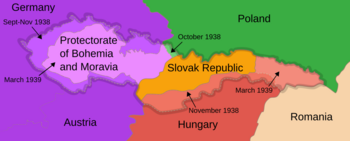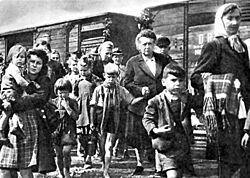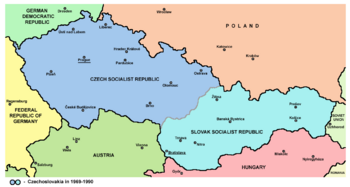History of Czechoslovakia facts for kids
Czechoslovakia, also known as Československo, was a country that existed in Central Europe from 1918 to 1992. It was formed after World War I when the large Austria-Hungary empire broke apart. The United States President Woodrow Wilson played a big part in its creation.
The people of Czechoslovakia were mainly Czechs and Slovaks. Even though their languages were similar, their lives were quite different. The Czech areas were more developed and industrial, while Slovakia was less so. This difference caused some challenges for the new country throughout its 75 years.
Contents
- How Czechoslovakia Began
- A New Idea for Czechs and Slovaks
- The First Republic: A New Start (1918–1938)
- The Second Republic: A Time of Trouble (1938–1939)
- World War II and Its Aftermath
- The Third Republic and Communist Takeover (1945–1948)
- The Czechoslovak Socialist Republic (1948–1989)
- Democratic Czechoslovakia (1989–1992)
- The Split of Czechoslovakia
- See also
How Czechoslovakia Began
A New Idea for Czechs and Slovaks
For a long time, Czechs and Slovaks lived under the rule of the Austro-Hungarian Empire. Czechs were ruled by Austria, and Slovaks by Hungary. This meant their societies and economies developed differently. But by the late 1800s, some smart people from both groups started thinking about joining together. They wanted to be free from the empire.
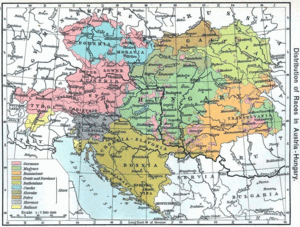
During World War I, three important leaders worked hard to make this dream happen: Tomáš Masaryk, Edvard Beneš, and Milan Rastislav Štefánik. They traveled to countries like the United States, France, and Britain to get support for an independent Czechoslovakia.
Many Czech and Slovak soldiers also helped. Over 90,000 volunteers formed the Czechoslovak Legions. They fought against the Central Powers (like Germany and Austria-Hungary) in Russia, France, and Italy. Their bravery helped convince the Allies (the countries fighting against the Central Powers) to support Czechoslovakia's independence.
The First Republic: A New Start (1918–1938)
On October 18, 1918, the leaders declared Czechoslovakia's independence. Just ten days later, on October 28, the country was officially created in Prague. Slovaks formally joined a couple of days later. Tomáš Garrigue Masaryk became the first president. In 1919, a peace treaty officially recognized the new country.
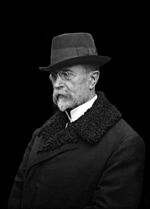
The new country faced some challenges because it had many different ethnic groups, including large numbers of Germans and Hungarians. However, Czechoslovakia also made great progress. It passed new laws to improve housing, social security, and workers' rights.
Economically, the country did very well. By 1938, Czechoslovakia was one of the top 10 industrial countries in the world. It was also a representative democracy, meaning people voted for their leaders. Unlike many other countries in Central and Eastern Europe at the time, Czechoslovakia remained a democracy throughout this period.
The Second Republic: A Time of Trouble (1938–1939)
Czechoslovakia had a lot of German people, especially in areas near the border called the Sudetenland. When Adolf Hitler and Nazi Germany became powerful in the 1930s, they wanted these German-speaking areas.
Hitler demanded that Czechoslovakia give up the Sudetenland. In September 1938, leaders from Germany, Italy, France, and Britain signed the Munich Agreement. This agreement forced Czechoslovakia to give the Sudetenland to Germany. The Czech people living there were forced to leave.
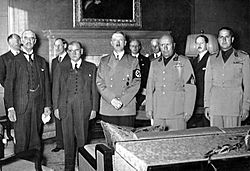
Feeling abandoned by its allies, Czechoslovakia had to agree. President Edvard Beneš resigned and went to London. Soon after, parts of Slovakia were given to Hungary, and a region called Trans-Olza was given to Poland.
The country became much smaller and weaker. It was renamed Czecho-Slovakia and divided into three self-governing parts: the Czech lands, Slovakia, and Ruthenia. But this didn't last long. On March 14, 1939, Slovakia declared its independence. The next day, Hitler's Germany took over the remaining Czech lands, creating the Protectorate of Bohemia and Moravia. Ruthenia was also taken by Hungary. This marked the end of independent Czechoslovakia for a while.
World War II and Its Aftermath
During World War II, Czechoslovakia was under German control. President Beneš and other Czechoslovak leaders formed a government-in-exile in London. They worked to get international support and fought alongside the Allies.
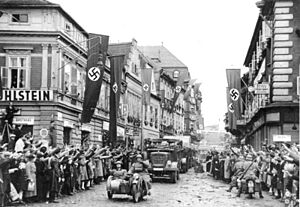
In 1942, two brave Czech and Slovak commandos, Jan Kubiš and Jozef Gabčík, assassinated a high-ranking Nazi official named Reinhard Heydrich. In revenge, the Nazis destroyed the village of Lidice, killing all the men and sending women and children to concentration camps.
By 1945, Soviet armies, helped by Czech and Slovak resistance fighters, liberated most of Czechoslovakia from the east. American forces liberated the city of Plzeň in the west. Prague was liberated by Soviet troops in May 1945.
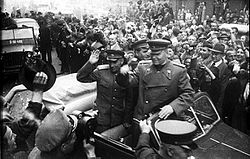
After the war, the region of Transcarpathia was given to the Soviet Union. Also, about 2.9 million ethnic Germans were expelled from Czechoslovakia, and their property was taken.
The Third Republic and Communist Takeover (1945–1948)
After the war, Czechoslovakia became a republic again. Its government was a mix of different parties, but three socialist parties, including the Communist Party of Czechoslovakia (KSČ), were very strong. Many Czechoslovaks were disappointed with Western countries because of the Munich Agreement, so they looked favorably on the Soviet Union and the Communist Party.
In the 1946 elections, the Communist Party won the most votes in the Czech areas. The anti-Communist Democratic Party won in Slovakia. Overall, the Communists had the most votes nationwide. Edvard Beneš remained president, and Communist leader Klement Gottwald became prime minister. The Communists gained control of important government ministries.
The Communists, supported by the Soviet Union, soon took full control. In February 1948, the non-Communist ministers resigned, hoping for new elections. But President Beneš did not call for them. The Communist-controlled police and workers' militias took over. On February 25, Beneš gave in, and the Communists officially took power. This event is known as the Czechoslovak coup d'état of 1948.
The Czechoslovak Socialist Republic (1948–1989)
After the Communist takeover, Czechoslovakia became a "people's democracy." It was closely tied to the Soviet Union, joining the Comecon (an economic group) and the Warsaw Pact (a military alliance). The government took control of all businesses and industries.
The Communist Party controlled everything, and people who disagreed with the government were often punished. The economy focused on heavy industry, but it didn't grow as fast as in some other countries.
In 1968, a period of reform began, known as the "Prague Spring." The new leader of the Communist Party, Alexander Dubček, wanted to create "socialism with a human face." This meant more freedom for people, including freedom of speech, press, and travel. People were excited and started to get involved in politics again.
The Prague Spring (1968)
Dubček's reforms worried the Soviet Union and other Warsaw Pact countries. They feared Czechoslovakia was moving too far away from communism. So, on the night of August 20-21, 1968, armies from the Warsaw Pact (except Romania) invaded Czechoslovakia.
The Czechoslovak government said the invasion was illegal. People protested peacefully, arguing with the soldiers. Dubček was arrested and taken to Moscow for talks. The result was the Brezhnev Doctrine, which meant the Soviet Union would not allow any country in its sphere of influence to leave the Communist path.
Dubček was removed from his position in April 1969 and replaced by Gustáv Husák. Many reformers were removed from the party. On January 19, 1969, a student named Jan Palach set himself on fire in Prague to protest the invasion, shocking the world.
Aftermath of the Prague Spring
The period after the invasion was called "Normalization." This meant bringing things back to the way they were before the reforms. There was a lot of political repression, and people had to follow the Communist Party's rules strictly. Life became stagnant, and many people were quiet, fearing punishment.
The only lasting change from the Prague Spring was that Czechoslovakia became a federation in 1969, with separate Czech and Slovak governments, though they were still controlled by the Communist Party.
Gustáv Husák became president in 1975. He focused on keeping control and providing a better standard of living, but the economy struggled in the 1980s. Czechoslovakia remained very dependent on the Soviet Union.
Some brave individuals and groups still challenged the government. In 1977, a group called Charter 77 published a manifesto criticizing the government for not respecting human rights. Many signatories were arrested or lost their jobs.
The Final Years of Communism
In the late 1980s, the Soviet Union's leader, Mikhail Gorbachev, started reforms. But Czechoslovakia's leaders were slow to change. Miloš Jakeš replaced Husák as party chief in 1987, but he didn't introduce many reforms.
People started to protest more openly. The first big anti-Communist demonstration happened in Bratislava in March 1988. More protests followed in Prague and other cities, especially on important anniversaries.
The Velvet Revolution (1989)
The end of communism in Czechoslovakia came quickly and peacefully in what is known as the Velvet Revolution. It started on November 16, 1989, with student protests in Bratislava and Prague.
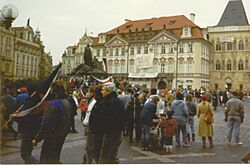
On November 17, the police violently broke up a peaceful student protest in Prague. This sparked huge public outrage. Groups like Charter 77 and others united to form the Civic Forum, led by the writer Václav Havel. This group quickly gained massive support from millions of Czechs. A similar group, Public Against Violence, gained support in Slovakia.
Faced with such strong public opposition, the Communist Party quickly lost power. Its leaders resigned in December 1989. On December 29, Václav Havel was elected President of Czechoslovakia. The speed of these changes was amazing, partly because the communist government was so unpopular and because the Soviet Union was no longer supporting it strongly.
Democratic Czechoslovakia (1989–1992)
After the Velvet Revolution, a new government was formed. In June 1990, Czechoslovakia held its first free elections since 1946. Civic Forum and Public Against Violence won by a landslide. The new parliament worked to make Czechoslovakia a true democracy.
However, Civic Forum soon realized it was better at overthrowing a regime than at governing. Different political parties started to form. The most important was the Civic Democratic Party, led by Václav Klaus.
The Split of Czechoslovakia
By 1992, Slovaks wanted more self-rule, which made it hard for the federal government to work. In the June 1992 elections, Václav Klaus's party won in the Czech lands, supporting economic reforms. In Slovakia, Vladimír Mečiar's party won, pushing for more Slovak independence.
Leaders like Havel tried to keep the country together, but the trend toward separation was too strong. In July 1992, President Havel resigned. Klaus and Mečiar then agreed that the two republics would become separate countries by the end of the year.
On January 1, 1993, the Czech Republic and Slovakia peacefully became independent states. They were immediately recognized by other countries. Despite some small disagreements about shared property, the relationship between the two new countries has remained peaceful.
See also
 In Spanish: Historia de Checoslovaquia para niños
In Spanish: Historia de Checoslovaquia para niños



